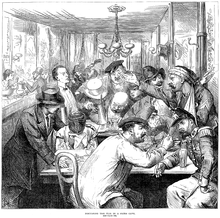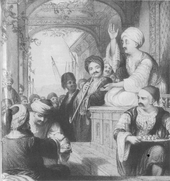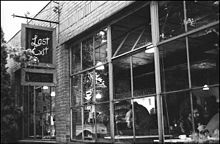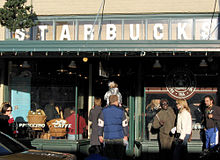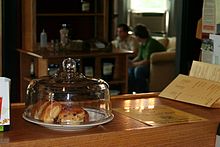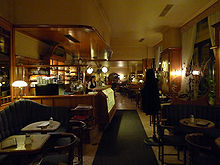- Coffeehouse
-
This article is about establishments that serve coffee. For the social event, see Coffeehouse (event). For the Sirius XM music channel, see The Coffee House. For other uses, see Coffee shop.
A coffeehouse or coffee shop is an establishment which primarily serves prepared coffee or other hot beverages. It shares some of the characteristics of a bar, and some of the characteristics of a restaurant, but it is different from a cafeteria. As the name suggests, coffeehouses focus on providing coffee and tea as well as light snacks. Many coffee houses in the Middle East, and in West Asian immigrant districts in the Western world, offer shisha (nargile in Turkish and Greek), flavored tobacco smoked through a hookah.
From a cultural standpoint, coffeehouses largely serve as centers of social interaction: the coffeehouse provides social members with a place to congregate, talk, write, read, entertain one another, or pass the time, whether individually or in small groups of 2 or 3.
Contents
History
The Ottoman chronicler İbrahim Peçevi reports the opening of the first coffeehouse in Istanbul:
Until the year 962 [1555], in the High, God-Guarded city of Constantinople, as well as in Ottoman lands generally, coffee and coffee-houses did not exist. About that year, a fellow called Hakam from Aleppo and a wag called Shams from Damascus came to the city; they each opened a large shop in the district called Tahtakale, and began to purvey coffee.[1]Various legends involving the introduction of coffee to Istanbul at a "Kiva Han" in the late 15th century circulate in culinary tradition, but with no documentation.[2]
Coffeehouses in Mecca soon became a concern as places for political gatherings to the imams who banned them, and the drink, for Muslims between 1512 and 1524. In 1530, the first coffee house was opened in Damascus,[3] and not long after there were many coffee houses in Cairo.
The 17th Century French traveler Jean Chardin gave a lively description of the Persian coffeehouse scene:
People engage in conversation, for it is there that news is communicated and where those interested in politics criticize the government in all freedom and without being fearful, since the government does not heed what the people say. Innocent games... resembling checkers, hopscotch, and chess, are played. In addition, mollas, dervishes, and poets take turns telling stories in verse or in prose. The narrations by the mollas and the dervishes are moral lessons, like our sermons, but it is not considered scandalous not to pay attention to them. No one is forced to give up his game or his conversation because of it. A molla will stand up in the middle, or at one end of the qahveh-khaneh, and begin to preach in a loud voice, or a dervish enters all of a sudden, and chastises the assembled on the vanity of the world and its material goods. It often happens that two or three people talk at the same time, one on one side, the other on the opposite, and sometimes one will be a preacher and the other a storyteller.[4]Coffee in Europe
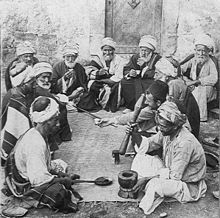 Coffeehouse in Palestine, c.1900.
Coffeehouse in Palestine, c.1900.
In the 17th century, coffee appeared for the first time in Europe outside the Ottoman Empire, and coffeehouses were established and quickly became popular. The first coffeehouses reached Western Europe probably through the Kingdom of Hungary, (thus this was the mediator between the Holy Roman Empire and the Ottoman Empire)[5] and appeared in Venice, due to the trafficks between La Serenissima and the Ottomans; the very first one is recorded in 1645. The first coffeehouse in England was set up in Oxford in 1652[6] by a Jewish man named Jacob at the Angel in the parish of St Peter in the East in a building now known as "The Grand Cafe". A plaque on the wall still commemorates this and the cafe is now a trendy cocktail bar.[7] Oxford's Queen's Lane Coffee House, established in 1654, is also still in existence today. The first coffeehouse in London was opened in 1652 in St Michael's Alley, Cornhill. The proprietor was Pasqua Rosée, the servant of a trader in Turkish goods named Daniel Edwards, who imported the coffee and assisted Rosée in setting up the establishment in St Michael's Alley, Cornhill.[8][9] By 1675, there were more than 3,000 coffeehouses in England.[10] Pasqua Rosée also established Paris' first coffeehouse in 1672 and held a city-wide coffee monopoly until Procopio Cutò opened the Café Procope in 1686.[11] This coffeehouse still exists today and was a major meeting place of the French Enlightenment; Voltaire, Rousseau, and Denis Diderot frequented it, and it is arguably the birthplace of the Encyclopédie, the first modern encyclopedia. America had its first coffeehouse in Boston, in 1676.[12] A rebuted tale of Vienna's first cafeteria said that it was founded in 1683 by a Polish resident, Jerzy Franciszek Kulczycki. In general, the first Polish cafes were founded in Warsaw in 1724 by one of the courtiers of Polish King August II Sass. However the whole culture of drinking coffee was itself widespread in the country in the second half of XVIII century. The first registered coffee house in Vienna was founded by the Greek Johannes Theodat (also known as Johannes Diodato) in 1685.[13][14] Fifteen years later, four Greek owned coffeehouses had the privilege to serve coffee.[13]
Though Charles II later tried to suppress the London coffeehouses as "places where the disaffected met, and spread scandalous reports concerning the conduct of His Majesty and his Ministers", the public flocked to them. For several decades following the Restoration, the Wits gathered round John Dryden at Will's Coffee House, in Russell Street, Covent Garden.[citation needed] The coffee houses were great social levellers, open to all men and indifferent to social status, and as a result associated with equality and republicanism. More generally, coffee houses became meeting places where business could be carried on, news exchanged and the London Gazette (government announcements) read. Lloyd's of London had its origins in a coffeehouse run by Edward Lloyd, where underwriters of ship insurance met to do business. By 1739, there were 551 coffeehouses in London; each attracted a particular clientele divided by occupation or attitude, such as Tories and Whigs, wits and stockjobbers, merchants and lawyers, booksellers and authors, men of fashion or the "cits" of the old city center. According to one French visitor, Antoine François Prévost, coffeehouses, "where you have the right to read all the papers for and against the government," were the "seats of English liberty."[15]
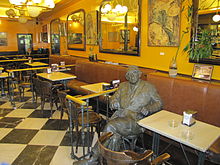 The statue of the writer Gonzalo Torrente Ballester in Café Novelty (Salamanca-Spain), founded in 1905.
The statue of the writer Gonzalo Torrente Ballester in Café Novelty (Salamanca-Spain), founded in 1905.
The banning of women from coffeehouses was not universal, but does appear to have been common in Europe. In Germany women frequented them, but in England and France they were banned.[16] Émilie du Châtelet purportedly wore drag to gain entrance to a coffeehouse in Paris.[17] In a well-known engraving of a Parisian coffeehouse of c. 1700,[18] the gentlemen hang their hats on pegs and sit at long communal tables strewn with papers and writing implements. Coffeepots are ranged at an open fire, with a hanging cauldron of boiling water. The only woman present presides, separated in a canopied booth, from which she serves coffee in tall cups.
The traditional tale of the origins of the Viennese café begins with the mysterious sacks of green beans left behind when the Turks were defeated in the Battle of Vienna in 1683. All the sacks of coffee were granted to the victorious Polish king Jan III Sobieski, who in turn gave them to one of his officers, Jerzy Franciszek Kulczycki. Kulczycki began the first coffeehouse in Vienna with the hoard. However, it is now widely accepted that the first coffeehouse was actually opened by an Greek merchant named Johannes Diodato.[14]
In London, coffeehouses preceded the club of the mid-18th century, which skimmed away some of the more aristocratic clientele. Jonathan's Coffee-House in 1698 saw the listing of stock and commodity prices that evolved into the London Stock Exchange. Lloyd's Coffee House provided the venue for merchants and shippers to discuss insurance deals, leading to the establishment of Lloyd's of London insurance market, the Lloyd's Register classification society, and other related businesses. Auctions in salesrooms attached to coffeehouses provided the start for the great auction houses of Sotheby's and Christie's. In Victorian England, the temperance movement set up coffeehouses for the working classes, as a place of relaxation free of alcohol, an alternative to the public house (pub).
In the 19th and 20th century, coffeehouses were commonly meeting point for writers and artists, across Europe.
Coffee in the United States
Coffee shops in the United States arose from the espresso- and pastry-centered Italian coffeehouses of the Italian American immigrant communities in the major U.S. cities, notably New York City's Little Italy and Greenwich Village, Boston's North End, and San Francisco's North Beach. From the late 1950s onward, coffeehouses also served as a venue for entertainment, most commonly folk performers during the American folk music revival. This was likely due to the ease at accommodating in a small space a lone performer accompanying himself or herself only with a guitar. Both Greenwich Village and North Beach became major haunts of the Beats, who were highly identified with these coffeehouses.
As the youth culture of the 1960s evolved, non-Italians consciously copied these coffeehouses. The political nature of much of 1960s folk music made the music a natural tie-in with coffeehouses with their association with political action. A number of well known performers like Joan Baez and Bob Dylan began their careers performing in coffeehouses. Blues singer Lightnin' Hopkins bemoaned his woman's inattentiveness to her domestic situation due to her overindulgence in coffeehouse socializing in his 1969 song "Coffeehouse Blues". Starting in 1967 with the opening of the historic Last Exit on Brooklyn coffeehouse, Seattle became known for its thriving countercultural coffeehouse scene; the Starbucks chain later standardized and mainstreamed this espresso bar model.
From the 1960s through the mid-1980s, many churches and individuals in the United States used the coffeehouse concept for outreach. They were often storefronts and had names like The Gathering Place (Riverside, CA), Catacomb Chapel (New York City), and Jesus For You (Buffalo, NY). Christian music (guitar-based) was performed, coffee and food was provided, and Bible studies were convened as people of varying backgrounds gathered in a casual "unchurchy" setting. These coffeehouses usually had a rather short life, about three to five years or so on average.[citation needed] An out-of-print book, published by the ministry of David Wilkerson, titled, A Coffeehouse Manual, served as a guide for Christian coffeehouses, including a list of name suggestions for coffeehouses.[19]
In general, prior to about 1990, true coffeehouses were little known in most American cities, apart from those located on or near college campuses, or in districts associated with writers, artists, or the counterculture. During this time the word "coffeeshop" usually denoted family-style restaurants that served full meals, and of whose revenue coffee represented only a small portion. More recently that usage of the word has waned and now "coffeeshop" often refers to a true coffeehouse.
Format
See also: List of coffeehouse chainsCafes may have an outdoor section (terrace, pavement or sidewalk cafe) with seats, tables and parasols. This is especially the case with European cafes. Cafes offer a more open public space compared to many of the traditional pubs they have replaced, which were more male dominated with a focus on drinking alcohol.
One of the original uses of the cafe, as a place for information exchange and communication, was reintroduced in the 1990s with the Internet café or Hotspot (Wi-Fi).[20] The spread of modern style cafes to many places, urban and rural, went hand in hand with computers. Computers and Internet access in a contemporary-styled venue helps to create a youthful, modern, outward-looking place, compared to the traditional pubs or old-fashioned diners that they replaced. Coffee shops like The Coffee Bean & Tea Leaf and Peet's now offer free Wi-Fi in most stores.
International variation
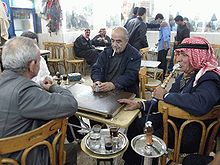 Coffeehouse in Damascus
Coffeehouse in Damascus
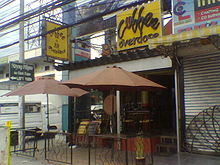 A coffee shop in Angeles City
A coffee shop in Angeles City
In the Middle East, the coffeehouse (مقهىً maqhan in Arabic, قهوه خانه qahveh-khaneh in Persian or kahvehane or kıraathane in Turkish) serves as an important social gathering place for men. Men assemble in coffeehouses to drink coffee (usually Arabic coffee) or tea, listen to music, read books, play chess and backgammon, and in many coffeehouses around the Middle East, hookah is traditionally served as well.
In Australia, coffee shops are generally called 'cafés'. Since the post-World War II influx of Italian immigrants introduced espresso coffee machines to Australia in the 1950s, there has been a steady rise in café culture. The past decade has seen a rapid rise in demand for locally (or on-site) roasted specialty coffee, particularly in Melbourne due in part to the hipster, student, or artist population, with the 'Flat-White' a popular coffee drink.
In the United Kingdom, traditional coffeehouses as gathering places for youths fell out of favour after the 1960s, but the concept has been revived since the 1990s by chains such as Starbucks, Coffee Republic, Costa Coffee, Caffè Nero and Prêt as places for professional workers to meet and eat out or simply to buy beverages and snack foods on their way to and from the workplace.
In France, a café also serves alcoholic beverages. French cafés often serve simple snacks such as sandwiches. They may have a restaurant section. A brasserie is a café that serves meals, generally single dishes, in a more relaxed setting than a restaurant. A bistro is a café / restaurant, especially in Paris. After the enlightenment era however, coffee houses became increasingly difficult to distinguish from taverns as they ceased to be popular meeting places for scientists and philosophers and were replaced by a growing number of tea gardens which served a drastically different purpose.
In China, an abundance of recently-started domestic coffeehouse chains may be seen accommodating business people. These coffee houses are more for show and status than anything else, with coffee prices often even higher than in the West.
In Malaysia and Singapore, traditional breakfast and coffee shops are called kopi tiams. The word is a portmanteau of the Malay word for coffee (as borrowed and altered from the Portuguese) and the Hokkien dialect word for shop (店; POJ: tiàm). Menus typically feature simple offerings: a variety of foods based on egg, toast, and coconut jam, plus coffee, tea, and Milo, a malted chocolate drink which is extremely popular in Southeast Asia and Australasia, particularly Singapore and Malaysia.
In parts of the Netherlands where the sale of cannabis is decriminalized, many cannabis shops call themselves coffeeshops. Foreign visitors often find themselves quite at a loss when they find that the shop they entered to have a coffee actually has a very different core business. Incidentally, most cannabis shops sell a wide range of (non-alcoholic) beverages.
In modern Turkey and the Arab World, coffeehouses attract many men and boys to watch TV or play chess and smoke shisha. Coffeehouses are called "'ahwah" (a colloquial form of standard قهوة qahwah) in the Arab world and combine serving coffee as well as tea and herbal teas. Tea is called "shāy", and coffee is also called "'ahwah". Finally, herbal teas, like hibiscus tea (called karkadeh, or Ennab) are also highly popular.[21]
Espresso bar
The espresso bar is a type of coffeehouse that specializes in coffee beverages made from espresso. Originating in Italy, the espresso bar has spread throughout the world in various forms. Prime examples that are internationally known are Starbucks Coffee, based in Seattle, Washington, U.S. and Costa Coffee, based in Dunstable, UK (the first and second largest coffeehouse chains respectively), although the espresso bar exists in some form throughout much of the world.
The espresso bar is typically centered around a long counter with a high-yield espresso machine (usually bean to cup machines, automatic or semiautomatic pump-type machine, although occasionally a manually-operated lever-and-piston system) and a display case containing pastries and occasionally savory items such as sandwiches. In the traditional Italian bar, customers either order at the bar and consume their beverages standing or, if they wish to sit down and be served, are usually charged a higher price. In some bars there is an additional charge for drinks served at an outside table. In other countries, especially the United States, seating areas for customers to relax and work are provided free of charge. Some espresso bars also sell coffee paraphernalia, candy, and even music. North American espresso bars were also at the forefront of widespread adoption of public WiFi access points to provide Internet services to people doing work on laptop computers on the premises.
The offerings at the typical espresso bar are generally quite Italianate in inspiration; biscotti, cannoli and pizzelle are a common traditional accompaniment to a caffe latte or cappuccino. Some upscale espresso bars even offer alcoholic beverages such as grappa and sambuca. Nevertheless, typical pastries are not always strictly Italianate and common additions include scones, muffins, croissants, and even doughnuts. There is usually a large selection of teas as well, and the North American espresso bar culture is responsible for the popularization of the Indian spiced tea drink masala chai. Iced drinks are also popular in some countries, including both iced tea and iced coffee as well as blended drinks such as Starbucks' Frappucino.
A worker in an espresso bar is referred to as a barista. The barista is a skilled position that requires familiarity with the drinks being made (often very elaborate, especially in North American-style espresso bars), a reasonable facility with some rather esoteric equipment as well as the usual customer service skills.
The espresso bar in the United Kingdom
Haunts for teenagers in particular, Italian-run espresso bars and their formica-topped tables were a feature of 1950s Soho that provided a backdrop as well as a title for Cliff Richard’s 1960 film Expresso Bongo. The first was The Moka in Frith Street, opened by Gina Lollobrigida in 1953. With their ‘exotic Gaggia coffee machine[s],...Coke, Pepsi, weak frothy coffee and...Suncrush orange fountain[s]’[22] they spread to other urban centres during the 1960s, providing cheap, warm places for young people to congregate and an ambience far removed from the global coffee bar standard which would be established in the final decades of the century by chains such as Starbucks and Pret A Manger.[23]
See also
- Caffé Lena
- Coffee culture
- Coffee Palace
- Coffee service
- English coffeehouses in the seventeenth and eighteenth centuries
- Greasy spoon
- Indian Coffee House
- Kafana
- Kava culture
- Manga cafe
- Parisian café
- Penny University
- Tea house
References
- ^ Quoted in Bernard Lewis, Istanbul and the Civilization of the Ottoman Empire, University of Oklahoma Press (reprint, 1989), p. 132 Google Books. ISBN 978-0806110608.
- ^ e.g. Psychicsahar.com
- ^ http://www.tomstandage.com/6G.html
- ^ "Coffee - The Wine of Islam". Superluminal.com. http://www.superluminal.com/cookbook/essay_coffee.html. Retrieved 2011-05-29.
- ^ "Kávéházak a dualizmus-kori Kolozsváron". Epa.hu. http://www.epa.hu/00400/00458/00065/2003honap5cikk294.htm. Retrieved 2010-09-21.
- ^ "Coffee History - Learn all about the history of coffee and things you never know. Did you know section". Koffeekorner.com. 2000-03-30. http://www.koffeekorner.com/koffeehistory.htm. Retrieved 2011-05-29.
- ^ "Pasqua Rosee". Oxforddnb.com. http://www.oxforddnb.com/view/article/92862. Retrieved 2011-05-29.
- ^ Weinberg, Bennett Alan; Bonnie K. Bealer (2002). The World of Caffeine: The Science and Culture of the World's Most Popular Drug. Routledge. p. page 154. ISBN 0-415-92722-6.
- ^ Wild, Anthony (2005). Coffee A Dark History. W. W. Norton & Company. p. page 90. ISBN 0393060713.
- ^ "JavaScript Detector". Nestleprofessional.com. http://www.nestleprofessional.com/uk/en/SiteArticles/Pages/History_of_Coffee.aspx. Retrieved 2010-09-21.
- ^ Procope.com; Nestlé UK - History of Coffee[dead link]
- ^ "America's First Coffeehouse | Massachusetts Travel Journal". Masstraveljournal.com. http://masstraveljournal.com/page/quick-facts/americas-first-coffeehouse. Retrieved 2010-09-21.
- ^ a b Teply, Karl: Die Einführung des Kaffees in Wien. Verein für Geschichte der Stadt Wien, Wien 1980, Vol. 6. p. 104. citated in: Seibel, Anna Maria: Die Bedeutung der Griechen für das wirtschaftliche und kulturelle Leben in Wien. p. 94 online available under: Othes.univie.ac.at, pdf
- ^ a b Weinberg, Bennett Alan; Bonnie K. Bealer (2002). The World of Caffeine: The Science and Culture of the World's Most Popular Drug. Routledge. p. page 77. ISBN 0-415-92722-6.
- ^ Prévost, Abbé (1930) Adventures of a man of quality (translation of Séjour en Angleterre, v. 5 of Mémoires et avantures d'un homme de qualité qui s'est retiré du monde) G. Routledge & Sons, London, OCLC 396693
- ^ "Coffee History". Archived from the original on 2007-09-15. http://web.archive.org/web/20070915014128/http://www.humboldtcoffee.com/History.htm. Retrieved 2007-10-27.
- ^ "Gabrielle Emilie le Tonnelier de Breteuil du Chatelet - and Voltaire". http://www.visitvoltaire.com/emilie_du_chatelet_bio.htm. Retrieved 2007-10-27.
- ^ WebCite query result
- ^ Sources: Tim Schultz, Director, "Jesus For You". A Coffeehouse Manuel, Bethany Fellowship, 1972.
- ^ "Julius Briner Message Board". Investorshub.advfn.com. http://investorshub.advfn.com/boards/board.aspx?board_id=16089. Retrieved 2010-09-21.
- ^ "Ahwa's in Egypt". Hummusisyummus.wordpress.com. 2007-10-31. http://hummusisyummus.wordpress.com/2007/10/31/my-life-in-the-ahwa/. Retrieved 2010-09-21.
- ^ Lyn Perry, ‘Cabbages and Cuppas’, in Adventures in the Mediatheque: Personal Selections of Films, (London: BFI Southbank / University of the Third Age, 2008), pp 26–27.
- ^ See Perry, ‘Cabbages and Cuppas’ and ‘The Coming of the Cafes’, Classic Cafes (1999–2008): specifically the section headed 1953....
Further reading
- Brian Cowan (2005), The Social Life of Coffee: The Emergence of the British Coffeehouse, Yale University Press
- Markman Ellis (2004), The Coffee House: a cultural history, Weidenfeld & Nicolson
- Ray Oldenburg, The Great Good Place: Cafes, Coffee Shops, Community Centers, General Stores, Bars, Hangouts, and How They Get You through the Day. New York: Paragon Books, 1989. ISBN 1-56924-681-5
- Tom Standage, A History of the World in Six Glasses, Walker & Company 2006, ISBN 0802714471
- AhmetYaşar, "The Coffeehouses in Early Modern Istanbul: Public Space, Sociability and Surveillance", MA Thesis, Boğaziçi Üniversitesi, 2003. Library.boun.edu.tr
- Ahmet Yaşar, "Osmanlı Şehir Mekânları: Kahvehane Literatürü / Ottoman Urban Spaces: An Evaluation of Literature on Coffeehouses", TALİD Türkiye Araştırmaları Literatür Dergisi, 6, 2005, 237–256. Talid.org
Coffee Topics - Economics
- Fair trade
- Health effects
- History
Production by
countrySpecies and
varietiesMajor
componentsProcessing Preparation Popular
beverages- Affogato
- Americano
- Bicerin
- Cà phê sữa đá
- Café au lait
- Café con leche
- Café Cubano
- Cafe mocha
- Caffè corretto
- Caffè macchiato
- Cappuccino
- Carajillo
- Coffee milk
- Cortado
- Espresso
- Flat white
- Frappuccino
- Galão
- Greek frappé coffee
- Iced coffee
- Indian filter coffee
- Ipoh white coffee
- Irish coffee
- Kopi Luwak
- Latte
- Latte macchiato
- Liqueur coffee
- Long black
- Red eye
- Ristretto
- Turkish coffee
Substitutes Lifestyle Categories:- Coffee houses
- Types of restaurants
Wikimedia Foundation. 2010.

